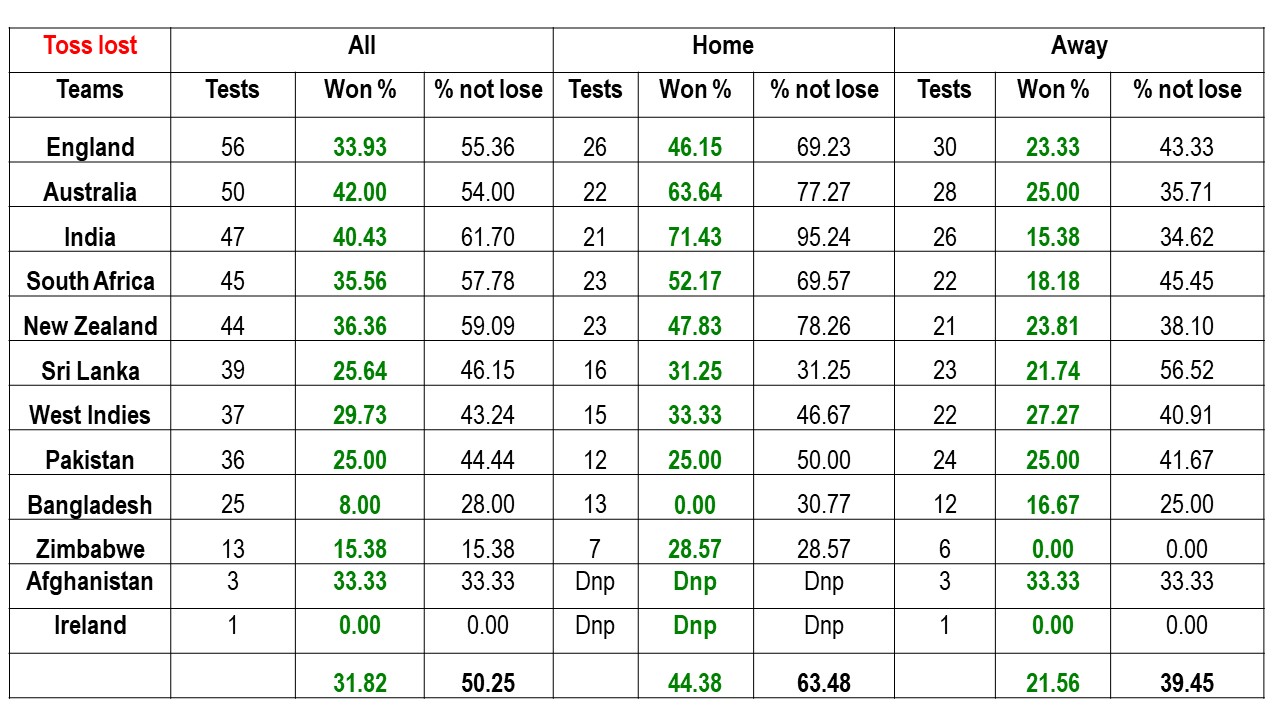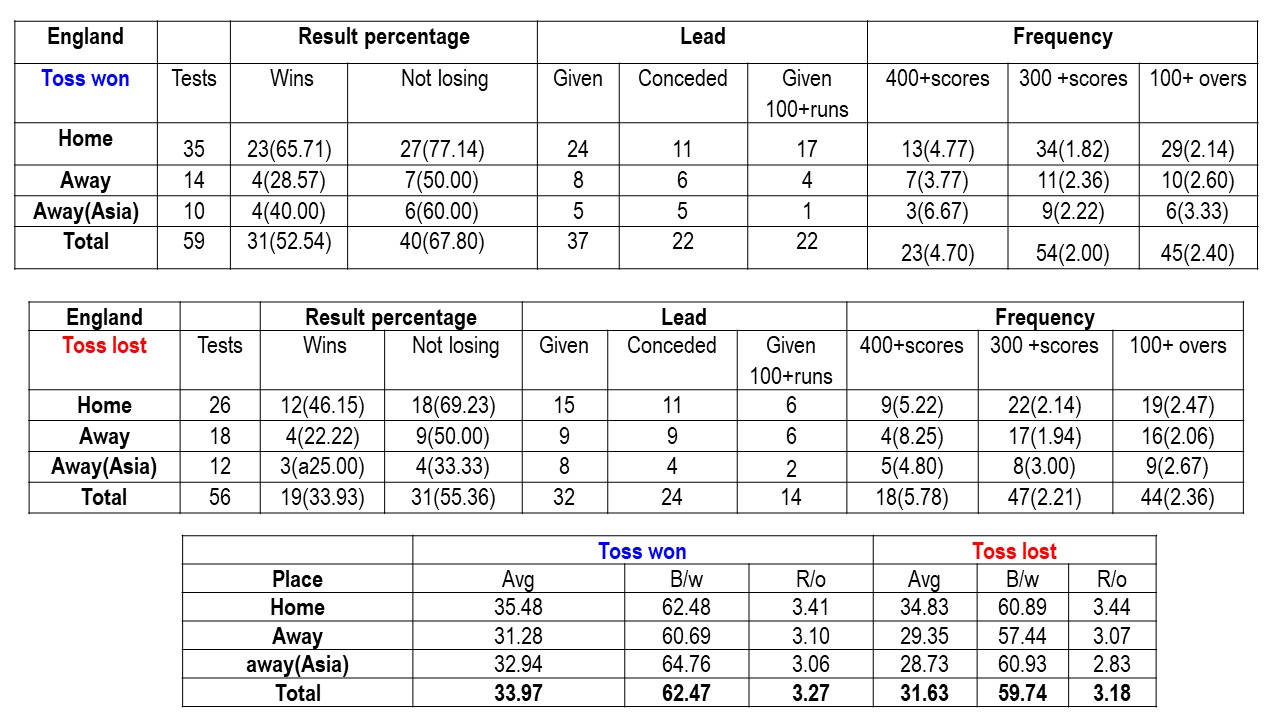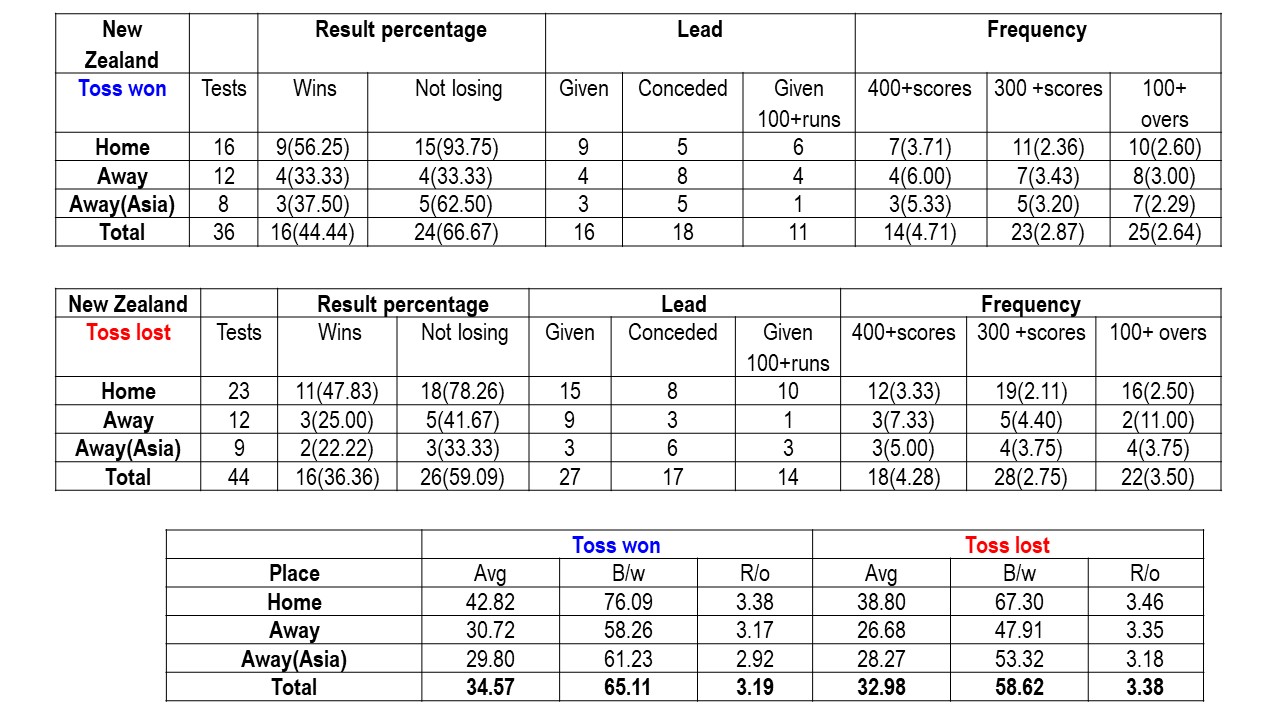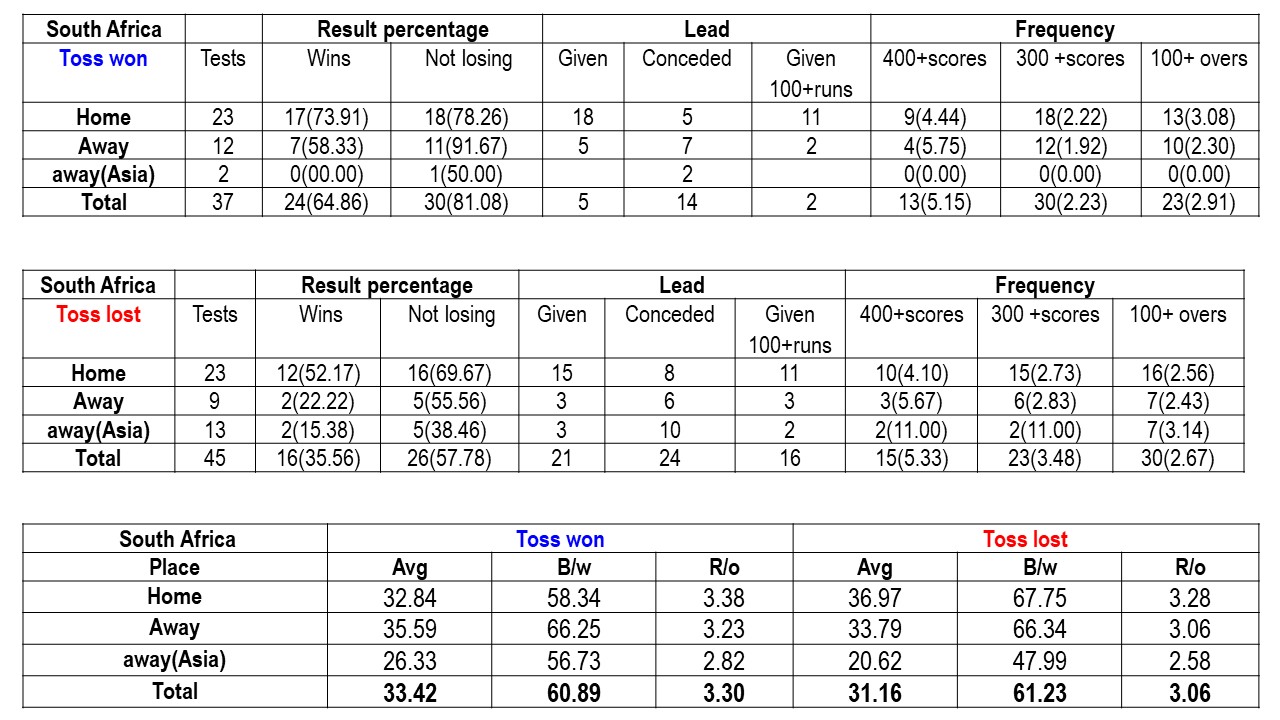Lately toss factor has become the key issues in Test cricket. Some feel it should be abolished and replaced by visiting teams allowed to make decision whether to bat or bowl. I think sport is about being unpredictable otherwise it is not a sport!.
However I feel this theory has escalated and rightly so. Lately there is undue advantage from weather and surface for host teams. One can do very less about the weather, but MCC and ICC can standardize pitches across cricketing nation!.
I think 5 day test cricket allows teams to come back if they are willing to adapt to unfamiliar condition. The weather and surface might not favour visiting teams, but 5 day is enough time for them to prepare, adapt and execute their plan and same time ICC/MCC need to regulate pitch conditions so that home teams don’t have undo advantage.
Here is how teams fared when winning/losing a toss
Keeping this in mind I have few elements that tilts the balance.
Home and away advantage and disadvantage
1st innings Lead (100 plus)
Team scores of over 400 runs /100 overs
All (Home, neutral and away including Asian countries)
| Description | |
| Toss/lead = 55.22% | There is 55% success of taking a lead for teams that wins the toss |
| Toss /1st bat = 68.41 % | Teams usually(68.41%) bat first after winning the toss |
| Toss/1st bat/lead = 57.45 % | Advantage of lead is higher(57.45%) if teams bat first after winning the toss |
| Toss/100+ lead = 37.81% | 100+runs lead is not regular (37.81%) if teams win toss and take a lead(irrespective of 1st bat or 2nd bat) |
| Toss/1st bat/100+ runs lead = 39.27% | Chances of 100 + runs lead is slightly better(39.27%) if teams choose to bat first after winning the toss |
| Toss/1st bat/win = 54.55% | More than half the time(54.55%) teams win if they win the toss and elect to bat first |
| Toss/lead/win = 72.07% | Wining 72% of tests after teams took “any amount” lead after winning the toss(irrespective of 1st bat or 2nd bat) |
| Toss/1st bat/lead/win = 77.84% | Chances of winning a test is higher (77.84%) if teams win toss, bat first, take “any amount” lead |
| Toss/100+ runs lead/win = 80.26% | There is 80% chance of winning a test, if teams win toss, bat first, take 100 plus runs lead |
| Toss /1st bat/100 + runs lead/win = 86.11 % | Winning almost is inevitable if teams bat first (after winning toss) and take 100 plus lead!. |
Keeping the above structure I decided to analyse home and away results for teams since Jan 2011
Home
- Toss = 54.56%
- Toss/lead = 63.25 %
- Toss/100 plus lead = 45.58%
- Toss /1st bat = 67.90%
- Toss/1st bat/lead = 66.43 %
- Toss/1st bat/100 plus lead = 47.94%
- Toss/1st bat/win = 68.49
- Toss/lead/win = 77.94 %
- Toss/1st bat/lead/win = 85.56
- Toss/100plus lead/win = 85.71%
- Toss /1st bat/100 plus lead/win = 91.43%
It is very clear from above data that winning the toss is first step to success and if teams are able to take 100 plus lead than winning becomes inevitable!.
Away(including neutral, Asian nations)
- Toss = 46.63%
- Toss/lead = 45.98%
- Toss/100 plus lead = 28.87%
- Toss /1st bat = 68.98
- Toss/1st bat/lead = 47.28%
- Toss/1st bat/100 plus lead = 29.45%
- Toss/1st bat/win = 38.76%
- Toss/lead/win = 62.79%
- Toss/1st bat/lead/win = 65.57%
- Toss/100plus lead/win = 70.37%
- Toss /1st bat/100 plus lead/win = 76.31%
Similarly to home performance the formula remains same when teams play away from home. The difference is marginal percentage (toss, 1st bat, 100 plus lead)
If a Team scores 400+ in 1st innings then success rate is 63.98%
……….yet scoring 400 runs is not easy as we find out below
Percentage of 400 plus runs scored against win %
400 scores – 1st inn 29.50%….. success rate 63.98 %
400 scores – 1st bat/1st inns = 34 %………success rate 63.97%
400 scores 2nd bat/1st inns = 25% …….success rate 64.00 %
400 scores – 1st inn/ Lead given (any amount) = 84.32% …….success rate 71.37%
400 scores -1st inn/ Lead of 100 plus runs = 72.03 % ……success rate 77.06 %
If we add both toss and 400 plus scores together then success rate is 65.71%
……….yet scoring 400 runs is not easy as we find out below
Toss factor + 400 scores
1st inns/400 scores = 34.82 % …..success rate 65.71%
1st Inns/1st bat (400 scores) = 38.55 % ………success rate 65.09%
2nd bat/1st inn = 26.77% …….success rate 67.64%
Now let us look at how top teams have performed in last 9 years.
India
In recently concluded series where India lost 0-2 to New Zealand. They were send it to bat in both games. The first test was a nightmare for India as they were bowled out for 165 and then couldn’t take advantage to New Zealand’s poor start, eventually conceded a lead of -183 runs!.
The second test was more even with India taking a tiny lead of 7 runs, yet they collapsed in second innings not giving enough target for their bowlers to defend. In this series only once 300 plus runs were scored, NZ scoring 348 in 1st inns/1st test match
If toss was the factor then India should have won their previous series in New Zealand where they toured in 2014. The 2-test series was lost 0-1 but India had won the toss in both tests. They chose to bowl on both occasion, allowing New Zealand to slip away after their poor start. This series was a high scoring series, NZ twice went past 500 runs( 503 & 680) and India twice went past 300 runs (366 & 438)
Below tables is toss factor for India at home and away.
When toss was won by India – They have been very regular in scoring big totals(400 plus runs) – and that can happen if you can bat long(100+overs) enough to pile on runs.
When toss was lost by India Interestingly toss factor does not matter for India at home as they have 100% rate of not losing a test match. India’s frequency of scoring 400 plus runs is decent enough for them to win test matches. In above table it is clear that inspite not winning the toss they have consistent in batting for long period and scoring 300/400 plus runs regularly. It is only when they travel in non-Asian countries their frequency is reduced!. I guess same philosophy applies to non-Asian teams when they travel to Asia!.
Fascinatingly at home toss factor does not matter for India – they have more than 90% not-losing a test match, which no other team has either toss win or lose toss.
Australia
Australia always bats first (82.35%) when they win the toss and their success of not losing the game is 82.35%!. On the other hand if they lose the toss than success is 42% and not losing a test is 54%. The good thing for them is lead factor and frequency of 300+ and batting for 100 + overs.
England
England success rate is equally balanced. It is placed decently at 52.54% and 34 % if they win or lose a toss. Their frequency of scoring 400 plus has been great and one of the factor that has helped them do that is – have a long innings – viz bat 100 plus overs in every test irrespective of toss.
New Zealand
Like England there is a balance toss factor for New Zealand. Although their fortress is very secured at home. They have highest % (93.75)of not losing a test match after winning the toss at home!. They are followed by Australia and India.
It is shocking to know this fact –that if they lose a toss they give more 100+ runs lead! South Africa is another team that has same fact
South Africa
South Africa toss factor record is pretty decent. Their recent performance in Asia has fallen down considerably.
Nevertheless they are capable of taking a lead regularly (especially 100 + runs) inspite of not winning the toss. Therefore their frequency of scoring big totals, or batting for 100 plus overs is almost same.
Pakistan
It is only after 2019 Pakistan started playing at home with UAE being their second home. Hence all performance in UAE is considered home matches. They like India do rely on toss factor. Nevertheless they are incapable of regularly posting 400 plus away from home. 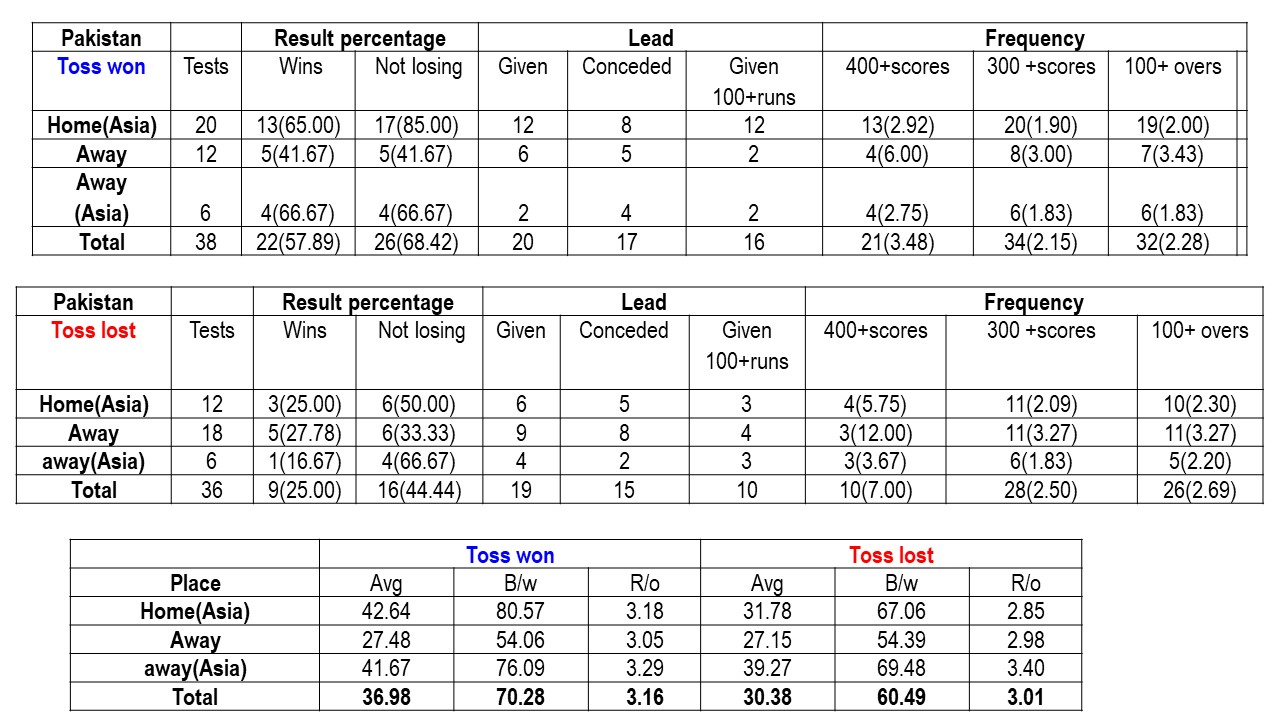
Sri Lanka
Sri Lanka totally relies on toss to win, or not lose a test match. They also rely to score big, bat long and take lead!. They are the only team that depends entirely on toss factor.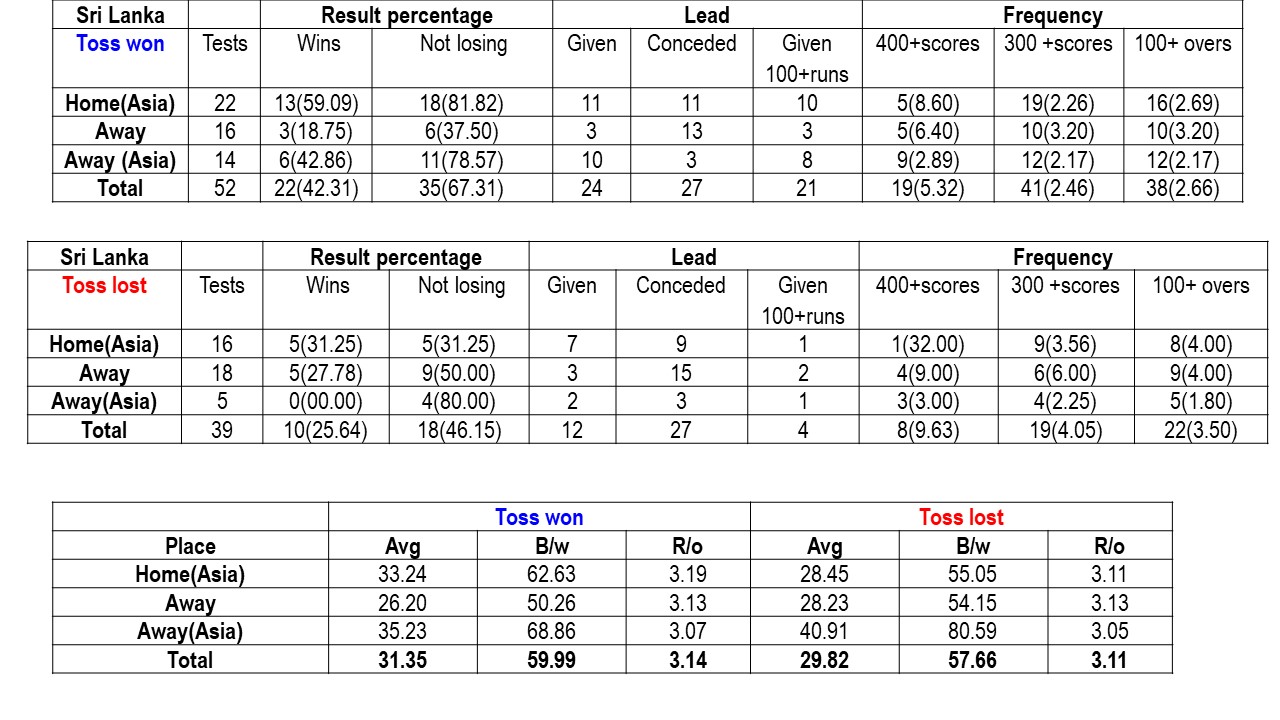
West Indies
West Indies like Sri Lanka and others rely on toss factor. However lately they are making an effort of not lose a test match if they don’t win the toss, especially away from home. They need to work on scoring big runs, because their frequency of scoring big score is very less, nevertheless frequency of batting for 100+overs is excellent!.
All data is from Jan 2011 till March 2020.


